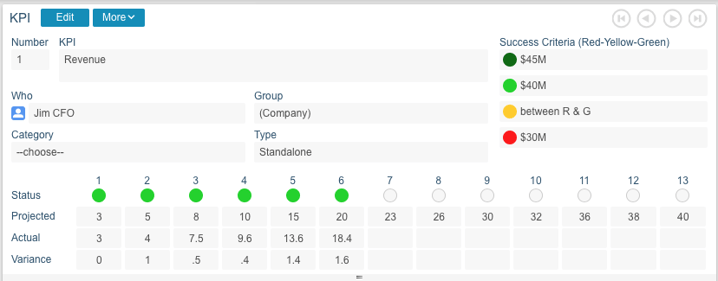Those of you using the Rhythm tool to track and discuss your KPIs weekly have probably  seen the Projected, Actual and Variance fields on each KPI record.
seen the Projected, Actual and Variance fields on each KPI record.
Some teams have mastered those fields and are using them to help predict success and failure and make adjustments along the way during their13-Week Race. Other teams are still learning how to maximize the power of Projected, Actual and Variance to help them win as a team.
Here are some best practices we’ve learned:
- Fill out the Projected field for all 13 weeks at the beginning of the quarter. It should be cumulative. For example, if Green for your Revenue KPI is $40M, $40M should be in the Projected field for Week 13. The owner of the KPI should work backward from that number and fill in amounts for Weeks 1-12. Perhaps they anticipate being at $20M in Week 6, $23M in Week 7, etc.
- Actuals and Variance should be filled in weekly as data. The Actual number should give a quarter-to-date, cumulative number. In our example, in Week 6, Actual revenue might be $18.4M. If the Projected was $20M, the Variance would be $1.6M.
- The weekly color selection should be the owner's best forecast of how the number should end for the quarter. Based on the Week 6 numbers in our example, the owner could still status Green based on their knowledge of the pipeline and what is expected to close. Or, with those same numbers, the owner could status Red because she knows the pipeline is dry.
- With any KPI, always put a Comment on the KPI whenever the status color selected is Yellow or Red. It's helpful to hear from the KPI's owner why he or she chose a color - especially if the color doesn't match the numbers. In the example where the numbers look good on the surface, but the owner statuses Yellow because of his pipeline knowledge, it's helpful to know if he anticipates missing Green by $5,000 or $100,000. That information should be included in the Comment, so it is transparent to the team and becomes part of the conversation at the Weekly Meeting.
This method helps the team see when a KPI is off-track as early as possible to allow for maximum adjustment time. We've learned that the raw data and numbers don't always tell the whole story, which makes the status color selected by the KPI's owner so important.
To really get the most out of your team’s use of Projected, Actual and Variance fields, the data has to prompt action. When a KPI is off track, do something about it!
With the proper data, status colors and strong weekly meeting habits, your team will have an effective early warning system in place. Simply have the right conversations, let the dashboards guide you and take action!
Photo Credit: iStock by Getty Images
Photo Credit: iStock by Getty Images



 LinkedIn
LinkedIn
 Facebook
Facebook


